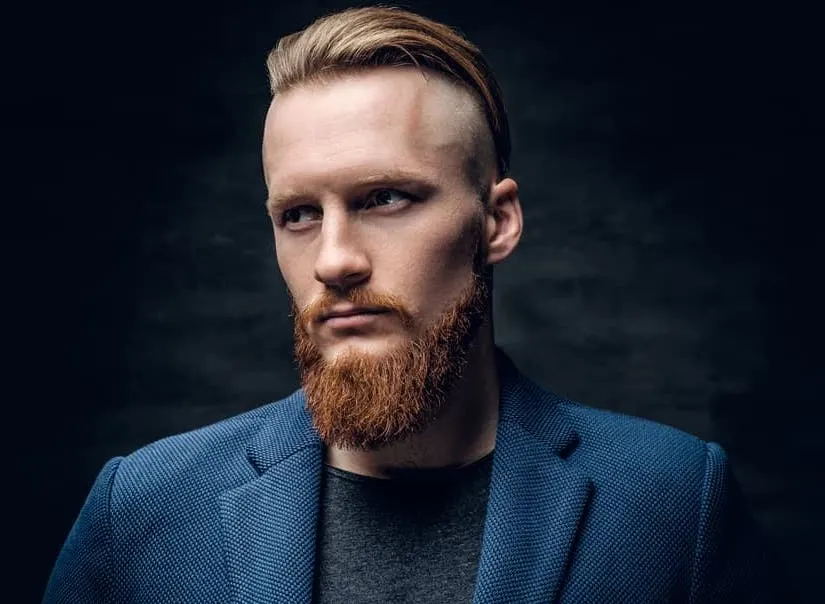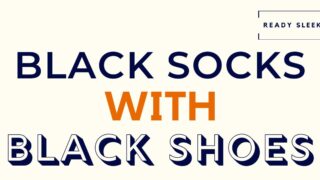Communication with barbers can be difficult at times, especially with hairstyles that are so poorly understood. So, how exactly do you ask for an undercut?
When asking for an undercut, specify how long you want the scissor-cut hair on top to be. You’ll also need to say how short and high you want the shaved or buzzed sides before they sharply transition into the long top.
Although that’s the short answer, there’s definitely more to it.
In order to ask for an undercut the right way, you’ll need to know exactly what it is, what the essential “undercut terminology is”, and a stepwise approach to doing it.
That’s exactly what you’re about to read. Let’s get to it.

Know Exactly What An Undercut Is
An “undercut” is a hairstyle where the sides are shaved or buzzed down short, while the top is left significantly longer and usually scissor-cut. The short sides transition into the long top high up and this transition is typically harsh with no blending or fading.
This sharp transition at the top of the sides into the long hair on top is what defines the undercut.
While the term “undercut” is now used to refer to any hairstyle that follows these general principles, the traditional undercut is a little more specific.
A proper undercut will usually have the top left long and slicked back. This slicking back of the top is a pretty important aspect of the traditional version of this style.
More modern variations of the undercuts have the top hair styled in many different ways, ranging from pompadours and crops, to comb overs.
Ultimately, if the sides are high and short, the top is long, and the two don’t blend into each other, it could reasonably be called an undercut.
For example, the “pompadour undercut” is one where the hair on top is contoured into a pomp (instead of slicked back) while the sides are left short and disconnected from the top.
Overall, every variation of the undercut will be eye-catching due to the lack of blending/fading from the short and high sides into the long hair on top.

Image From Deposit Photos
Essential Undercut Terminology
Understanding what these basic terms really mean is crucial when asking for an undercut. It’ll make communicating with your barber effectively a whole lot easier.
- Shaved – To cut the hair using a razor (manual or electric), not a clipper. It’s as short as you can go. Undercuts often have the sides completely shaved.
- Buzzed – Also known as “clipped”. The hair is cut using a pair of clippers and won’t be cut as short as a razor would. Undercuts can have the sides “buzzed” to a specific length instead of shaved.
- Fade – Where the sides gradually increase in length from the bottom to the top. Undercuts typically don’t have the sides faded except maybe a subtle taper at the bottom.
- Slick-Back – The hair on top is traditionally slicked back with undercuts. It’s swept back and slicked flat.
If you’re having the sides of your undercut buzzed instead of shaved, you’ll need to know how short you want to go with it.
Having a good understanding of clipper numbers is important here, as you’ll need to ask the barber for the sides to be clipped down to a specific number.
I’ve written a whole article on clipper guards and how they work if you’re interested. You can also click the links on the specific numbers below to see what to expect with each of them.
- #0 – 1/16 inch
- #1 – 1/8 inch
- #2 – 1/4 inch
- #3 – 3/8 inch
- #4 – 1/2 inch
- #5 – 5/8 inch
- #6 – 3/4 inch
- #7 – 7/8 inch
- #8 – 1 inch
How To Ask A Barber For An Undercut (6 Steps)
So it’s time for the haircut. This time, however, you’ll know exactly what to say to get the undercut you want and deserve.
By the end of this, you should be able to ask for an undercut like this example:
“I’d like an undercut, please. I’m hoping to slick the hair on top backward, so I’ll need around 4 inches left behind. I’d like the sides and back buzzed down to an even #1 length with a sharp transition into the top at the level of the temples.”
1. Ensure You Have Enough Length
Before you head to that barbershop, you’ll need to make sure you’ve got enough length for the style you’re hoping for.
Remember, traditional undercuts typically have the hair on top slicked back. If this is what you want, you’ll need to make sure the hair on top is long enough to slick back.
Although hair can be trained to slick back, hair does need to be a minimum length before it’ll slick back and stay that way.
This length is around 3.5 to 4 inches.
Learning how to slick back hair is an art in itself.
Even if you aren’t looking to slick the top hair of your undercut back, the bottom line here is that you should make sure you have enough length for the look you’re aiming for before you go for your cut.
2. Find A Photograph
Finding a photograph of the specific style of undercut you want, with the hair on top and the sides cut how you’d like it, is extremely useful.
Barbers (the good ones at least) like seeing a photograph of what you’re hoping for before they start cutting because it makes their job easier.
Their job is to give you the cut you’re hoping for and being able to see it firsthand without having to interpret what you’re saying is definitely helpful.
So, browse through some blogs, books, or magazines, and find a picture of the type of undercut you want.
Show it to the barber before they start cutting.
Even if you’ve got a picture to show them, however, it’s definitely worth knowing what to verbally ask for as well.
Read on to find out how to do that.
3. Say How Long You Want The Top
The key aspects of an undercut style are the long top, the short sides, and the high and harsh transition from one into the other.
Splitting it into these core components is useful when asking a barber for one.
First, start off by letting them know you want an “undercut”. You shouldn’t start any other way.
Then, let them know how long you want the hair on top to be.
Using your fingers to indicate how much you want trimmed off the top is helpful, but most barbers generally work in inches as well.
If you want to slick it back, you’ll want to leave at least 4 inches on top to be safe.
4. Specify How You Want The Top Styled
If you’re hoping to slick back your undercut, let the barber know this is what you’re hoping to do.
Alternatively, if you’re hoping to leave it in a fringe or comb it to one side, let the barber know that this is what you’re hoping to do.
At the end of the day, telling the barber how you intend on styling it is something you really don’t want to miss out.
It’ll influence how they cut it and will make it more likely that you’ll actually be able to style it the way you want to after the cut is done.
5. State How Short You Want The Sides
Remember, with undercuts the sides and back can either be buzzed or shaved, but will usually be cut down to the same length throughout.
Let the barber know whether you want the sides shaved or buzzed.
If you want them shaved, it’s simple enough – the barber will usually just use an electric shaver to achieve it.
If you want them buzzed, it’s important that you tell them what number you want it buzzed down to, as we went through in the “essential terminology” section earlier on.
6. Say How High You Want The Sides
Finally, let them know how high you want the sides. In other words, how high do you want the shaved/buzzed sides to go before it transitions into the long hair on top?
With undercuts, it’s often as high as the temples. However, you may want it a little lower than this depending on your personal preferences.
It’s also important to let the barber know that you don’t want the sides to be faded or blended into the long and scissor-cut hair on top. While this disconnection is typical of undercuts, it’s still worth specifying this just to be sure.
At this point, you’re done and should be able to ask for an undercut in a way that’s clear and concise.
Conclusion
While it isn’t the most complex of hairstyles, it still has enough variations to be confusing.
Hopefully, the undercut has now been decoded to the point where you can ask for the one you really want in a simple and effective way.
Enjoy.
Ready Sleek founder. Obsessed with casual style and the minimalist approach to building a highly functional wardrobe. Also a fan of classic, vintage hairstyles.







